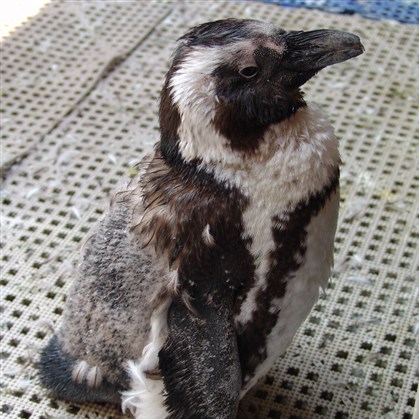Let's Talk About: Molting birds
September 17, 2014
A molting penguin at the National Aviary. credit: National Aviary.
Many birds undergo two very energy-demanding processes at this time of year: molt and migration. For adult birds these fall immediately on the heels of another very demanding activity: nesting. Consequently, birds have evolved various strategies for keeping their energy budgets balanced. One common strategy is the temporal separation of energy-demanding activities. For example, birds generally do not molt while they are nesting or migrating.
But, the feathers that make up birds’ plumages do need to be replaced if they are to continue to serve the important dual purpose of providing insulation and, for most species, the ability to fly. This is where molt, the process of shedding old and growing new feathers, comes in. Molt intensity (the number of feathers molting at the same time) and rate (the speed of individual feather growth) varies greatly among species.
Migratory songbirds, which have comparatively little time between the end of the temperate summer nesting season and the beginning of fall migration to distant tropical wintering grounds, have various molt strategies: Some molt intensely and rapidly, replacing all of their feathers in as little as five weeks; others start and then interrupt their molt, completing it later on the wintering grounds; a few delay molting altogether until after they reach their wintering grounds. In contrast, birds such as hawks and eagles, which hunt on the wing, have evolved a low-intensity, slow-paced molt strategy, in which individual feathers are gradually and continually replaced over many months, even during nesting and migration.
Of course, the birds living at the National Aviary molt, too. One species exhibits a very unusual molt strategy. Our African penguins undergo what is called “catastrophic molt,” which involves the rapid, nearly simultaneous shedding of all their feathers over the course of just a few weeks. They have been described as looking like “an exploded pillow” during this time. But, there is a good reason for this strategy.
For penguins, whose outer covering must be insulative, waterproof and hydrodynamic (the underwater equivalent of aerodynamic), the annual molt imposes a monthlong fast on dry land. When they are molting, African penguins lose an ounce of fat and a half ounce of protein every day to meet the energy demands of their intensive molt. To balance this, a seven-pound African penguin gains an additional 20 percent body mass, or 1½ pounds, in just a few weeks, and then sheds those extra pounds during its molt-induced fast. That’s like a 200-pound person gaining and losing 40 pounds in two months.
Visit the National Aviary during our fun-filled “Party With the Penguins” Sept. 27-28, and you will see our African penguins looking very sharp and sleek in their newly molted plumages. Special weekend activities will include taking selfies with our penguins, getting an opportunity to win your own birthday party with a penguin, and, for our younger visitors dressed in black-and-white party clothes, the chance to march in a penguin parade.
source



















No comments:
Post a Comment